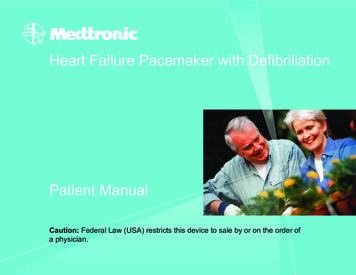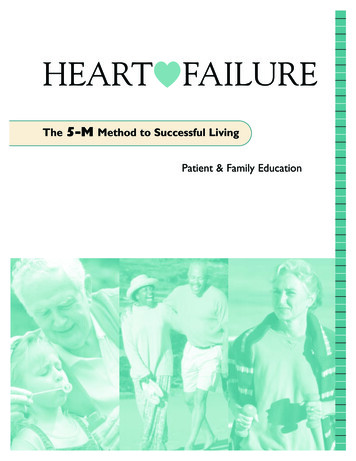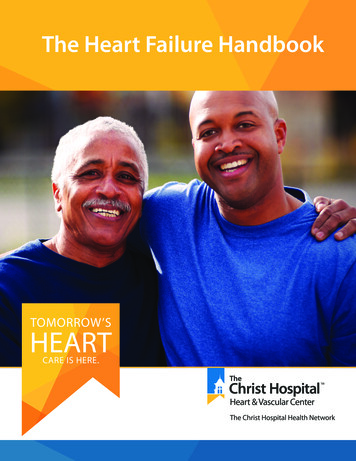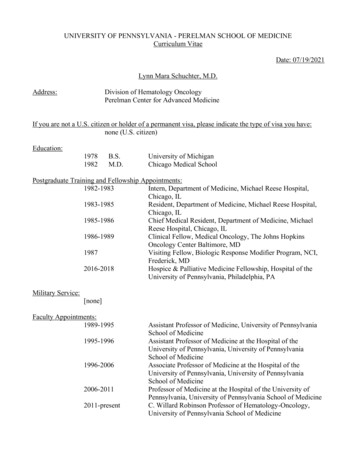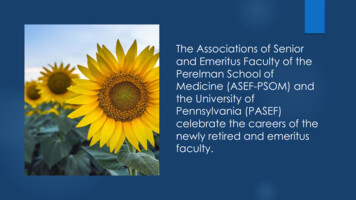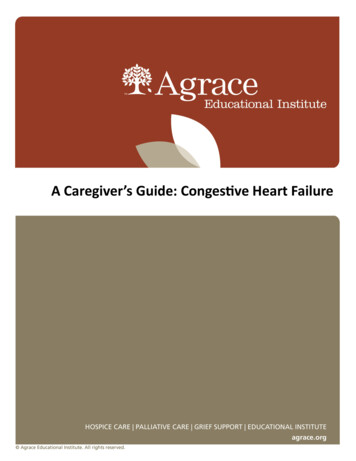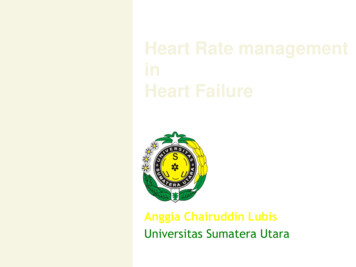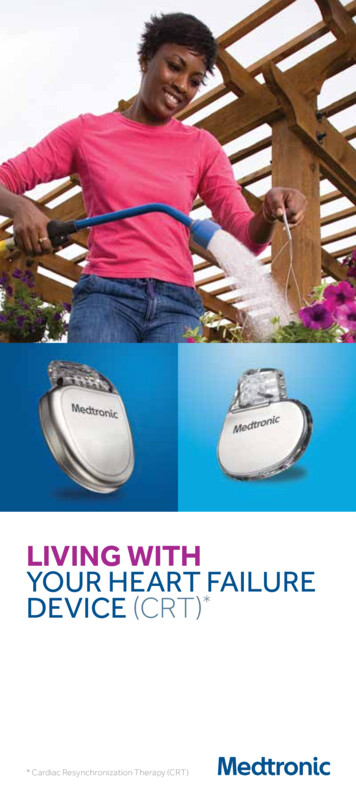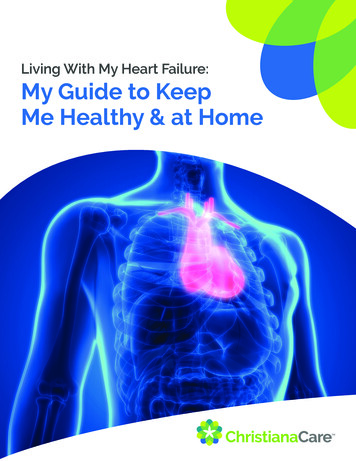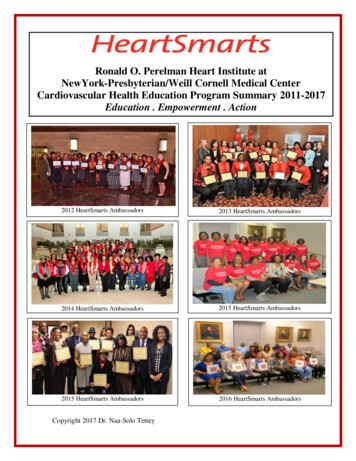
Transcription
Ronald O. Perelman Heart Institute atNewYork-Presbyterian/Weill Cornell Medical CenterCardiovascular Health Education Program Summary 2011-2017Education . Empowerment . Action2012 HeartSmarts Ambassadors2013 HeartSmarts Ambassadors2014 HeartSmarts Ambassadors2015 HeartSmarts Ambassadors2015 HeartSmarts Ambassadors2016 HeartSmarts AmbassadorsCopyright 2017 Dr. Naa-Solo Tettey
According to the Centers for Disease Control and Prevention (CDC), healthdisparities are preventable differences in the burden of disease, injury,violence, or opportunities to achieve optimal health that are experienced bysocially disadvantaged populations. The HeartSmarts program aims toeliminate health disparities through education, action, and empowerment.Disparities can be found in both health status and health care with membersof disadvantaged populations having worse health outcomes and oftenreceiving substandard treatment. An example of a chronic disease thatdemonstrates a health disparity is heart disease. Although heart disease is theleading cause of death and disability in the United States, itdisproportionately impacts members of racial and ethnic groups who havehigher rates of cardiovascular disease and its risk factors. Heart diseaseknows no boundaries and cuts across all socio-economic groups.The HeartSmarts Cardiovascular Health Education Program created byDr. Naa-Solo Tettey, MPH, MBA aims to reduce the incidence and increaseawareness of cardiovascular disease in underserved communities. The goalis to educate individuals, families, and communities about heart disease andits prevention. Through HeartSmarts the hope is to establish a coalition thatwill partner with educators, clinicians, and researchers in developing andimplementing cardiovascular health outreach programs.2
HeartSmarts Participant Feedback(Below is feedback based on program evaluations from participants taught byHeartSmarts ambassadors)“Excellent program. It taught me a lot of things I didn’t know that can causea heart attack and heart disease”“We must not abuse our body temple. This class made me more cognizant ofhow to take care of my health.”“The HeartSmarts program is a very good class. If I did not take this class Iwould not know half of the things about the heart and heart disease rightnow.”“The HeartSmarts classes was worth the sacrifices I have made to attendeach one. The value obtained is priceless because of the benefits I derivedfrom the simple changes I have made. I would not change the format of thepresentation in the text used because of its simplicity in getting the contentacross in understanding such complex health disciplines.”“The class lectures are very informative for me, happy for this program,wish it could continue because learning is wisdom, and I would like otherpeople who I know to get on this program and be healthier. The way theylectured was excellent”“The lecture was presented excellently, the lecturer was on time, alwaysprepared, and answered questions with clarity.”“My knowledge changed because at the end of the ten weeks I know if yourheart is smart your heart will also be happy”“I am now living a healthier lifestyle and as a result have lost weight and amthrilled about it. I exercise and am more health conscious”3
HeartSmarts Program HighlightsThe HeartSmarts program began in 2011 with the hopes of educating communities aboutcardiovascular health in a unique way. In 2012, nineteen HeartSmarts Ambassadors ofHealth completed the HeartSmarts training and successfully implemented the program intheir churches and communities. A total of 199 people representing 14 churchesthroughout the five boroughs completed the HeartSmarts program in 2012. At thebeginning of the program, these individuals had a variety of health conditions includinghypertension, diabetes, obesity, and heart disease. For the 199 participants, there wassignificant improvement in knowledge about heart disease and its prevention.More than half of the participants improved their blood pressure, lost weight, decreasedwaist circumference, and decreased BMI. In addition to this, all participants providedpositive program feedback and made statements such as, “I now feel empowered aboutmy health.” In 2013, eighteen HeartSmarts ambassadors of health representing 14churches completed the training with an additional 200 participants completing theHeartSmarts program. To date 130 ambassadors have been trained, and over 1000participants have attended a HeartSmarts class or seminar, with consistent programresults.HeartSmarts has been recognized as a model for community based health promotion. Amajor accomplishment for HeartSmarts in 2016 was having the first research paper fromthe program titled, “It's Like Backing up Science with Scripture": Perceptions ofHeartSmarts, a Faith-based Cardiovascular Health Education Program, published in theJournal of Religion and Health. HeartSmarts has also been presented at nationalconferences including, The American Public Health Association annual meeting, The 7 thAnnual Health Disparities Conference, The National Wellness Conference, and theAssociation of Black Psychologists annual meeting. In addition to this, partnerships havebeen formed with community organizations including The NAACP, The BoweryMission, The Northeastern Conference of Seventh-Day Adventists, and The NewAmerican Chamber of Commerce.As we celebrate this five-year milestone, the hope is to continue to expand the programand reach new communities. The work of the HeartSmarts ambassadors is much neededand we are grateful for your dedication.Naa-Solo Tettey, EdD, MPHCreator and Director of the HeartSmarts Program4
HeartSmarts in the NewsHeartSmarts has been recognized as a model for communitybased health promotion by The New York Daily News, TheNew York Times, The New York Post, The Harlem Times, andDNA Info. In addition to this, the HeartSmarts program hasbeen featured on many local community radio stations and wasalso filmed by ABC News-New York.5
For Underserved Communities, FaithBased Health LessonBy Paul DeBenedetto on May 16, 2012Eighteen people graduated from the "HeartSmarts" program on May 15, 2012.New York-PresbyterianMANHATTAN — Norma Wesley was sitting at the computer in her East Elmhurst homewhen half her body went numb. Years ago, Wesley's mother died of a stroke, so she knewthe signs.She picked up the phone and dialed 911. When Wesley was done, she called the womenshe was supposed to pick up, and informed them she couldn't take them to a churchmeeting.“I had a stroke, and I’m on the way to the hospital,” she said calmly.Almost seven years later, Wesley, now 71, has turned her life around: she’s 45 poundslighter, eats right, exercises, and now, she’s able to teach others in her church about heartdisease.6
Wesley and 17 other representatives from parishes in Brooklyn, Manhattan, Queens andStaten Island graduated Tuesday from a new program at Perelman Heart Institute atNewYork-Presbyterian/Weill Cornell Program.The program, entitled “HeartSmarts: A Faith-Based Cardiovascular Health EducationProgram,” works with the parishes to teach about heart disease prevention while usingbiblical scripture as a teaching tool.After her stroke, Norma Wesley was confined to a wheelchair. With the help of physicaltherapy, she was able to move on to a cane. She now walks with a limp. And afterTuesday’s graduation, located at the New York Academy of Medicine, she’s lookingforward to imparting the lessons she’s learned throughout her long life.“That limp to me is my humbleness,” Wesley said. “It reminds me of how far I’ve comefrom that wheelchair to today.”The program was the brainchild of Dr. Naa-Solo Tettey, who, after being hired by NewYork-Presbyterian in July of 2011, was charged with implementing a community healthoutreach program. She decided that working with churches was a good way to helpunderserved communities.“I hadn’t seen any programs that incorporated actual scriptural text, used the Bible as ateaching tool,” Tettey said.So she took actual lines from the Bible and used them to teach secular health lessons.“If your body is ‘an instrument of righteousness,’ than you should take care of it,“ shesaid, referencing Romans 6:19. “For people that are faith-based, that would mean morethan a doctor saying ‘eat well and exercise.’"The recent graduates agree. The Rev. Dr. Rose Ellington Murray, 69, of Harlem’sTrinity AME church, thought she was going to learn basic health lessons. But by addingin biblical lessons, she said, she’s now also able to relate those lessons more easily to hercongregation.“When you cite something or make something relevant through scripture, it becomesmore beneficial, and they become more apt to learn,” she said.Eva Barrett, another graduate, certainly found it easier to learn. The 64-year-old BedfordStuyvesant resident is looking forward to bringing the lessons she learned back to hercongregation, Crossover Baptist Church.“It was a beautiful experience,” Barrett said. “Your body is a temple, your body is cleanand you should do whatever you can to keep it that way.”7
In Church, Using the Bible as a Guide for Healthy LivingBy ERIC P. NEWCOMERAugust 17, 2012At Mt. Olivet Gospel Church in Corona, Queens, church members participated in a classfocusing on healthy habits.Inside Mt. Olivet Gospel Church in Corona, Queens, about a dozen older AfricanAmerican women, some of them overweight, were perched in the pews reading intently.But they were not focused on the Bible. Instead, it was information on maintaining ahealthy heart.Then they prayed, calling on God to grant their group the power to apply what theylearned. “Father, help us to use it in a good way and to share it with someone else,” saidMargaret McHenry, a member of the congregation who helped lead the class.Similar gatherings are being held this summer in churches throughout New York City,part of a new strategy aimed at blacks and Latinos who have high rates of heart ailmentscaused by being overweight.Organized by the Ronald O. Perelman Heart Institute at NewYork-PresbyterianHospital/Weill Cornell Medical Center, the program brings together science and religion.Heart disease is the leading cause of death in the United States, according to the Centersfor Disease Control and Prevention.The program seeks to use faith and lessons from the Bible to persuade minoritycongregants to embrace healthier lifestyles.Brenda Marshall-Stewart, a congregant who led the class at Mt. Olivet Gospel Church,said that the Bible might be a more effective motivator for members who take their faithseriously. And because congregants tend to trust their pastors or fellow congregants, they8
might be more willing to heed their advice than the words of doctors they see onlyperiodically.“We have more of a responsibility to our community than just taking care of people whoare sick,” said Dr. Holly Andersen, the director of education and outreach at the HeartInstitute. “We have a huge responsibility of educating our community of how not to endup in the hospital.”During the 10-week course, participants learn about desirable cholesterol levels and heartrates and set specific goals that they review at every meeting.For Viola Thom, 68, who attends meetings at Flatbush Seventh-day Adventist Church inBrooklyn, the program has made her a closer reader of labels at the grocery store. She haseliminated a lot of cheeses from her diet and is eating more fruits and vegetables.“I don’t like it, but I’m doing it because it’s good for my heart,” Ms. Thom said. TheBible has played a key role, she said. “It reinforces it very much because if it’s in thebook we want to do it.”Alema Ashley-Love, 56, works at a nursing home and attends the classes at Mt. Olivet inCorona. She takes pills for diabetes and has high blood pressure, she said. One sessionincluded a review of a chart depicting healthy weight ranges.“I didn’t think I was fat until I looked at that chart,” she said.That helped motivate her. “I want to live longer,” she said. And, she added, Jesus didn’tdie so that she could live an unhealthy life.The classes have been held in about 18 churches throughout the city. They are led bychurch members and pastors who first go through an extensive training regimen run byDr. Naa-Solo Tettey. The training includes the same curriculum covered in the classes,including Bible verses to be used – though ministers are free to add their own. By the endof the training, the instructors are armed with an arsenal of data, quotes and religiouswisdom.While the curriculum is currently designed around Christian scriptures, Dr. Tettey saidshe hoped that the program could expand beyond Christian denominations when newclasses start in the fall. The Heart Institute plans to assess whether the program yieldstangible health benefits among participants.At the Flatbush Seventh-day Adventist Church, classes are run by the Rev. RichardCalhoun. One participant, Beverly Henry, 59, said the program had coaxed her intowalking more.She has also replaced white bread with whole wheat bread and is reducing the amount ofsalt in her diet. It has been an adjustment, she acknowledged. “I know that it’s helping a9
lot,” she said. “I’m getting into it.” The Bible has been a source of inspiration, Ms. Henryadded. “It goes hand and hand. What the Bible is saying is true.”Mr. Calhoun said many of his congregants could not wait until the fall classes start.“I think that it’s an eye-opener,’’ he said, “that this is part of my Christian experience.”10
Uptown Talk: New York Presbyterian HeartSmarts classes preachbenefits of heart-healthy lifestyleDr. Naa-Solo Tettey created a curriculum that uses Scriptures to bringheart-healthy messages to local church congregationsThursday, April 25, 2013By Clem RichardsonDr. Naa-Solo Tettey teaches a class of HeartSmarts, the faith-based cardiovascular health education programcreated by Tettey and Dr. Holly Andersen at the hospital’s Ronald O. Perelman Heart InstituteDr. Holly Andersen got the bucks. Dr. Naa-Solo Tettey wrote the manual.Which is why 22 black and Hispanic men and women gathered at New York PresbyterianHospital’s Weill Medical Center stood and chanted Philippians 4:13 in unison — “I cando all things through Christ, who strengthens me.”The verse was the theme of that night’s HeartSmarts class, the faith-based cardiovascularhealth education program which Andersen and Tettey created at the hospital’s Ronald O.Perelman Heart Institute just over two years ago.It was the last night of the ten-week program, which uses holy scripture to educatetrainers how to teach church members the benefits of living a heart-healthy lifestyle.Andersen, Perelman’s director of education and outreach, said she came up with the ideathree years ago after testifying before the City Council about heart disease among thecity’s female population.“Most of the Councilmen there were from underserved neighborhoods,” Andersen said.“One man said his church had a fish fry every Friday night, and he always had friedchicken after church on Sunday.“I was thinking, if we could teach them how to make fish and fry chicken in a healthyway, that’s how you change generations.” Andersen said.11
Andersen said she had read small studies documenting the effectiveness of faith-basedteaching to reach underserved — lessons cloaked in scripture — in reaching underservedpopulations she would normally only see “when they end up here with heart attacks.”“It really is about prevention, and teaching them to live healthier,” Andersen said. “Andnot just teaching, but motivating. If you have congregations already devoted to God, andyou look at your heart, your health, your life as a gift that should be treated well andtaken care of because that’s what God wants you to do, it’s a much more motivatingmessage.”Andersen secured a Fridolin Charitable Trust grant to fund the program, then turned toTettey to create the manual they would use to train trainers, who would return to theirreligious institutions to teach congregation members.Tettey, Perelman’s Cardiovascular Health Education and Community OutreachCoordinator, found out early in her research that “most of these programs were faithplaced and not faith-based, meaning they were happening in the churches but notincorporating the belief systems, scriptures or anything like that.“I thought it would be interesting to actually incorporate the scriptures and utilize churchculture as a way of educating church members,” she said. “The church sets the standardfor certain practices in people’s lives. We want them to create a culture of health.”The medical base of the instruction manual is taken from “Every Heartbeat is Life”curriculum created by the National Heart, Lung and Blood Institute, a book already in thepublic domain.It took her three months to find the Biblical verses to combine with the manual herself.“I would research passages that had to do with health, then choose the ones that resonatedthe most with me,” Tettey said. “Going through the Bible, I picked the ones I thoughtwere the best.”The result is straightforward and inspiring. Lesson 1, for example, about knowing yourrisk for heart disease, quotes 1 Corinthians 6:19-20 — “Do you not know that our body isa temple of the Holy Spirit, who is in you, who you have received from God?.Therefore,honor God with your body.”The curriculum has proven popular at Perelman and at churches throughout the fiveboroughs. Linda Thompson, leader of Health Ministries at Harlem’s Abyssinian BaptistChurch, said congregation members were already signing up for the program. “Theycan’t wait for me to finish here,” Thompson said. Class member Monica Walsh, fromGreater Allen AME Cathedral of New York in St. Albans, Queens, said she had lost morethan 15 pounds during the course by following the manual.The HeartSmart program is part of a study that will document the results.12
The Harlem TimesFaith-Based Cardiovascular Education Program Helps CongregationsBecome Heart SmartBy: Yasmein JamesFebruary 18, 2015Before Reverend Dr. Rose Ellington Murray became a HeartSmarts Ambassador, shewasn’t practicing what she was preaching when it came to her health.As a health care professional, she knew the importance of taking care of her body, but itwasn’t until she began teaching the HeartSmarts curriculum to her congregation inHarlem that she began actually doing it.“Sometimes when you are in the health profession, you think you know a lot,” saidMurray. “We tell people to do things we are not doing. I now do what I tell people to do.”That means drinking more water, which she originally found unbearable until she beganputting lemon slices in it. That also means not just buying anything because she is in arush and checking food labels for things such as sodium. If it’s too high, she looks for alow-sodium alternative.Those are lessons she learned from HeartSmarts, a twelve-week faith-basedcardiovascular health education program, which aims to educate high-risk communitiesabout heart disease and its prevention. In addition to heart disease, the class focuses onhigh blood pressure, high cholesterol, stress, diabetes, nutrition and the importance ofincluding physical activity into your daily routine.It is sponsored by the Ronald O. Perelman Heart Institute at the New York PresbyterianHospital\Weill Cornell Medical Center. It was created by Dr. Naa-Solo Tettey inconjunction with Dr. Holly Andersen and Dr. Carla Boutin-Foster.“I noticed initially that there were programs that were in the churches, but usually theywere created by other organizations,” said Tettey. “While it had a health purpose, it didnot incorporate the faith system of the church itself.” To help participants immediatelysee how health is directly linked to the word, the first chapter of the curriculum is entitled“Your Body Is a Temple – Know Your Risk for Heart Disease.”13
For Trinity African Methodist Episcopal Church, where Murray is the pastor, theinclusion of scriptures was key in helping the congregation become healthier.This was especially true for the older congregants who have become more flexible abouttaking control of their health because they are able to see it in the scripture. “Withscripture for the people, they can identify that the spiritual is not detached from thephysical and that the physical is not detached from the emotional,” said Murray.Because of it, her congregation has made an active decision to dilute juices, serve morevegetables than meat at gatherings as well as serve more wholesome snacks like branmuffins for programs. They are also practicing portion control, which Murray driveshome by retelling the story of the two fish and five loaves. The story discusses whenChrist was on the mountain and was able to feed 5,000 people with what appeared to benot enough food.For Marie Lucette Momplaisir, a 20-year member of Our Lady Refuge Church inBrooklyn, the program couldn’t have come at a better time.When she began participating in the program, she was having difficulty getting up thestairs. She was also concerned about her heart and her sugar. Though she is also in thehealth profession, she believes that she has learned so much with each class that shetaught. She views the program as a way to continue education and she plans on doing itfor a long time.“Even me, when I finished with the twelve sessions it’s not enough,” said Momplaisir.“You have to continue doing it. You eat for today, but you have to eat for tomorrow.”Her congregation will graduate from the program on February 22.For 44-year-old Barry Braxton, the reason to participate was a personal one. He lost hismother and one of his aunts to strokes. While he had participated in other health-relatedprograms, Braxton was looking forward to participating in this program because of theinclusion of scripture. He is a deacon at the DRC Fellowship Inc. in Queens and knew hisknowledge of the word and health would ensure his success in the program.During the course of the program, Braxton lost two inches from his waist and dropped 10pounds by limiting things that were not good for his healthy lifestyle choice such as pork,fried food, eggs, milk and cheese.He said maintaining a healthy lifestyle has always been a main concern at his church, butnow they have the information to help them achieve their goals.“When it comes down to information as far as science is concerned, we didn’t have theinformation,” he said. “Now that we have the numbers and what it means, we can take itto the next level of being a real healthy church.”14
Jennifer Thompson, 44, has always been passionate about health and teaching others.That is one of the main reasons she became a HeartSmarts ambassador. The other reasonis to set an example for her two young girls. Thompson, a nurse by profession, loves thatthe program teaches the importance of eating well. It’s one of the things she hopes hergirls will retain while they grow older.Though it’s harder to get them on-board especially seeing their classmates eating donuts,chips and bagels, she explains that eating well will help them become who they want tobe when they get older. “A healthy breakfast will really boost your mind power and yourcapabilities,” she said. “All of these things will play an important role if you don’t wantto be sick or go to the hospital.” For her, participating in the program is about putting youand your health first.“It’s not being selfish, it’s about being good to yourself” said Thompson. “It’s lovingwho you are and saying to yourself I am going to do what it takes to make sure that I amwell whether it’s physically, spiritually or emotionally.” She went on to say that we haveto retrain our brains to know that putting ourselves first is about recognizing self-worthand importance.Thompson is the health coordinator for the Flatbush Seventh Day Adventist Church inBrooklyn. She became an ambassador in 2012.15
Through community outreach, students and faculty tacklehealth disparities among poor and minority New YorkersBy Heather SalernoThe HeartSmarts program at the Perelman Institute highlights the important role thatreligion can play in disease-prevention efforts in underserved communities. Created byNaa-Solo Tettey, EdD, the Institute’s cardiovascular health education and communityoutreach coordinator, HeartSmarts uses the Bible to teach minority churchgoers about thebenefits of a healthier lifestyle. "I saw a lot of programs that were faith-based, meaningthat they were in the churches but they weren't actually utilizing the church culture or theBible," says Tettey. "They were just programs people had created and given to thechurches. So I thought it would be interesting to combine the science with actualscripture."For example, during a lesson about understanding one'srisk of heart disease, Tettey quotes from I Corinthians:"Do you not know that your bodies are temples of theHoly Spirit, who is in you, whom you have receivedfrom God? You are not your own. . . . Therefore honorGod with your bodies." She incorporates other keypassages when talking about the importance of physicalactivity, portion control, and optimal heart rates andcholesterol levels.Through a variety of programs,Weill Cornell is reaching out tosocioeconomically disadvantagedNew Yorkers.Since 2012, Tettey has trained about eighty"ambassadors" from the Flatbush Seventh-DayAdventist Church in Brooklyn, the Presbyterian Churchof St. Albans in Queens, and dozens of other ministries throughout New York City andLong Island. Those representatives then educate fellow congregants who sign up for aten-week HeartSmarts course. In the first year alone, more than half the participantsreduced their blood pressure and waist circumference. The message, however, has spreadbeyond those who attend class. "Now, after church services, they're not serving friedchicken anymore. They're serving baked chicken and vegetables," says Tettey. "So evenif every person in the church doesn't take the class, they're impacted in some way byhaving that ambassador there."16
Faith-Based Program Is an Effective Tool for Cardiovascular Disease Education,Study FindsHeartSmarts, an education program developed at the Ronald O. Perelman HeartInstitute at NewYork-Presbyterian/Weill Cornell Medical Center, celebrates its fifthanniversaryNewswise — NEW YORK (September 14, 2016) -- HeartSmarts, a faith-basedcommunity education and outreach program, is an effective method for teachingunderserved communities about heart health in New York City, according to a studypublished in the Journal of Religion and Health. Based at the Ronald O. Perelman HeartInstitute at NewYork-Presbyterian/Weill Cornell Medical Center, the program marks itsfifth year of collaborating with local churches to improve understanding ofcardiovascular disease, the leading cause of death in the United States, according to theCenters for Disease Control and Prevention.Led by Dr. Holly Andersen, director of education and outreach at NewYorkPresbyterian/Weill Cornell Medical Center and clinical associate professor of medicine atWeill Cornell Medicine, and Dr. Naa-Solo Tettey, coordinator of cardiovascular healtheducation and community outreach at NewYork-Presbyterian/Weill Cornell MedicalCenter, HeartSmarts aims to reduce cardiovascular disease in the New York metropolitanarea’s underserved communities by developing a coalition of faith-based and communitypartners. The program uses a unique, faith-based curriculum that references biblicalscripture in covering topics such as major risk factors for heart disease. Representativesare recruited from churches and other organizations to teach them about heart health. Thegraduates of the program become health ambassadors who take the lessons they havelearned back to their congregations and pass on their knowledge to their respectivecommunities in a formal instructional environment.According to the study, 199participants from 14 church sites completed the ambassador-led sessions, with 137providing detailed feedback via an open-ended survey developed by NewYorkPresbyterian and Weill Cornell Medicine researchers. One of the researchers’ primarygoals was to assess the use of scripture to educate participants about cardiovascularhealth. Responses to the survey suggest this approach was well received. One participantwrote: “[The approach is] ideal, and points the way to taking care of our bodies — it islike using scripture to backup science.”“While our message has a strong spiritualcomponent, it is important to note that most participants said that what they learned mostwas how to live a heart healthy lifestyle,” said Dr. Tettey, the lead author of the study.“The responses we have received suggest that this innovative approach is seen favorablyby the people we are trying to reach.”Although this program focused on participants whoattend religious services, there is also potential to reach their social networks whichincludes individuals who do not attend formal church services. In addition, the course ismodified each year based on feedback from participants to ensure that it remains relevantto its constituents. “In the five years since we began this program, we have received somuch positive feedback and seen so many success stories,” Dr. Anderson said. “We hopeto continue to develop these innovative approaches that reach patients directly in theircommunities by collaborating with people and institutions they trust most.”17
Ambassador SpotlightA Survivor’s Story: Beverly BruinOn the sunny afternoon of Monday, September 28, 2015, at approximately high noon,while alone, I casually strolled to my car after a routine follow up visit with myneurologist regarding my knee and lower back. As I stuck the car key into the door, I wasinstantly struck in my chest with a stabbing pain like never before, coupled with my backand chest seeming to be racing to meet each other while squeezing my insides together. Icl
The program was the brainchild of Dr. Naa-Solo Tettey, who, after being hired by New . At Mt. Olivet Gospel Church in Corona, Queens, church members participated in a class . Alema Ashley-Love, 56, works at a nursing home and attends the classes at Mt. Olivet in Corona. She takes pills for diabetes and has high blood pressure, she said.
